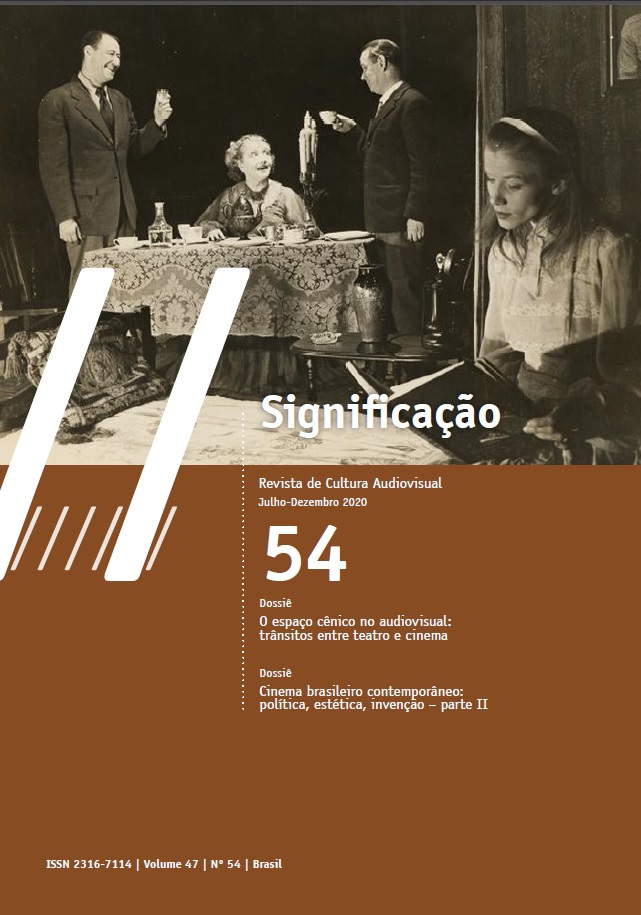From opera to cinema, from cinema to opera: the art of actor-singer
DOI:
https://doi.org/10.11606/issn.2316-7114.sig.2020.164518Keywords:
Acting, Silent film, Opera, TheaterAbstract
This paper raises questions concerning the participation of opera singers in silent movies and the influence of that experience on the creation of a more naturalist form of acting in opera. Considering the activity of acting under a broader perspective, we reflect about stage pictorialism, a common practice in non-musical theater by the end of the 19th century which is also adopted in opera. Our considerations are guided by a well-documented case of film screening, Metropolitan Opera House soprano Geraldine Farrar as Carmen in the homonym 1915 movie by Cecil B. De Mille.
Downloads
References
ALTMAN, R. “Early film themes: Roxy, Adorno, and the problem of cultural capital”. In: GOLDMARK, D.; KRAMER, L.; LEPPERT, R. (org.). Beyond the soundtrack: representing music in cinema. Los Angeles: University of California Press, 2007. p. 205-224.
ANDERSON, G. B. “Geraldine Farrar and Cecil B. DeMille: the effect of opera on film and film on opera in 1915”. In: PERRIAM, C.; DAVIES, A. (ed.). Carmen: from silent film to MTV. Amsterdam: Editions Rodopi B.V., 2005. p. 23-35.
AUMONT, J. O cinema e a encenação. Lisboa: Texto & Grafia, 2008.
BRANSTETTER, L. Angels and Artic Monkeys: a study of pop-opera crossover. 2006. Dissertação (Mestrado em Música) – Universidade de Cincinnati, Cincinnati, 2006.
BREWSTER, B.; JACOBS, L. Theatre to cinema: stage pictorialism and the early feature film. New York: Oxford University Press, 2016. Disponível em: https://bit.ly/3i7Faw0. Acesso em: 26 jun. 2020.
CHION, M. La musique au cinéma. 2. ed. rev. e aum. Paris: Fayard, 2019.
COSTA, F. C. “Primeiro Cinema”. In: MASCARELLO, F. (org.). História do Cinema Mundial. Campinas: Papirus, 2006. p. 17-52.
ESSE, M. “The silent diva: Farrar’s Carmen”. In: HENSON, K. Technology and the diva: sopranos, opera, and media from romanticism to the digital age. New York: Cambridge University Press, 2016. p. 89-103.
FARRAR, G. “The Story of my Life”. Photoplay, Chicago, 1919. Disponível em: https://bit.ly/3i5nsZQ. Acesso em: 7 nov. 2019.
FRYER, P. The opera singer and the silent film. Jefferson: Mc Farland, 2005.
FRYER, P.; USOVA, O. Lina Cavalieri: the life of opera’s greatest beauty, 1874-1944. Jefferson: Mc Farland, 2004.
GUNNING, T. The cinema of attraction[s]: early film, its spectator and the avantgarde. In: STRAUVEN, W. (ed.). The cinema of attractions reloaded. Amsterdam: Amsterdam University Press, 2006. p. 381-388.
HENSON, K. Opera acts: singers and performance in the late nineteenth century. Cambridge: Cambridge University Press, 2015.
HICKS, A. Singer and actor: acting technique and the operatic performer. Milwaukee: Amadeus Press, 2011.
IRINA, M. The spell of live performance: HD opera and liveness today. 2016. Tese (Doutorado em Filosofia) – Carleton University Ottawa, Ottawa, 2016.
JELGERHUIS, J. Theoretische lessen over de gesticulatie en mimiek, gegeven aan de kweekelingen van het fonds ter opleiding en onderrigting van tooneelkunstenaars aan den Stads Schouwburgte Amsterdam. Amsterdam: P. Meijer Warnars, 1827. Disponível em: https://bit.ly/38gLI73. Acesso em: 30 jun. 2020.
JOE, J. Opera as soundtrack. Surrey: Ashgate, 2013.
LALEU, A. “Dans le monde de l’opéra, le physique prime désormais sur la voix” Slate.fr, Paris, 22 fev. 2018, 9:41. Disponível em: https://bit.ly/3eCzDeH. Acesso em: 15 nov. 2019.
LEVINE, L. Highbrow/Lowbrow: the emergence of cultural hierarchy in America. Cambridge: Harvard University Press, 1990.
MARON, D. Para além da ópera: Tito Schipa e sua presença no Brasil no início do século XX. 2018. Dissertação (Mestrado em Música) – Universidade Federal do Rio de Janeiro, Rio de Janeiro, 2018.
NASH, E. Geraldine Farrar: opera’s charismatic innovator. 2. ed. Jefferson: McFarland, 2012.
PAULIN, S. “Richard Wagner and the fantasy of cinematic unity: the idea of Gesamtkunstwerk in the History and Theory of Film Music”. In: BUHLER, James; FLINN, C.; NEUMEYER, D. Music and Cinema. Middletown: Wesleyan University Press, 2000. p. 58-84.
PEARSON, R. Eloquent gestures: the transformation of performance style in the Griffith Biograph films. Berkeley: University of California Press, 1992.
PEREIRA, C. E. A música no cinema silencioso no Brasil. Rio de Janeiro: Museu de Arte Moderna, 2014.
RINDOM, D. “Celluloid diva: staging Leoncavallo’s Zazà in the cinematic age”. Journal of the Royal Musical Association, Cambridge, n. 144, v. 2, p. 287-321, 2019.
SCHROEDER, D. Cinema’s illusions, opera’s allure: the operatic impulse in film. New York: Continuum International Publishing Group Inc., 2002.
SIDDONS, H. Practical illustrations of rhetorical gesture and action. London: Sherwood, Neely and Jones, 1822.
TAMBLING, J. “Film aspiring to the condition of opera”. In: TAMBLING, J. Opera, ideology and film. Basingstoke: Palgrave Macmillan, 1987. p. 41-67.
Downloads
Published
Issue
Section
License
Copyright (c) 2020 Luíza Beatriz Alvim, Diana Maron

This work is licensed under a Creative Commons Attribution-NonCommercial 4.0 International License.
Authors who publish in this journal must agree with the following terms:
- Authors keep their copyrights and grant the journal first time publication rights, having their articles simultaneously licensed under the Creative Commons Attribution License, which allows sharing texts with authorship recognition and first publication on this journal for non-commercial purposes.
- Authors are allowed to make additional contracts, for a non-exclusive distribution of the article’s version published on this journal (e.g.: publishing in institutional repositories of articles or as a book chapter), with authorship recognition and first publication on this journal.
















